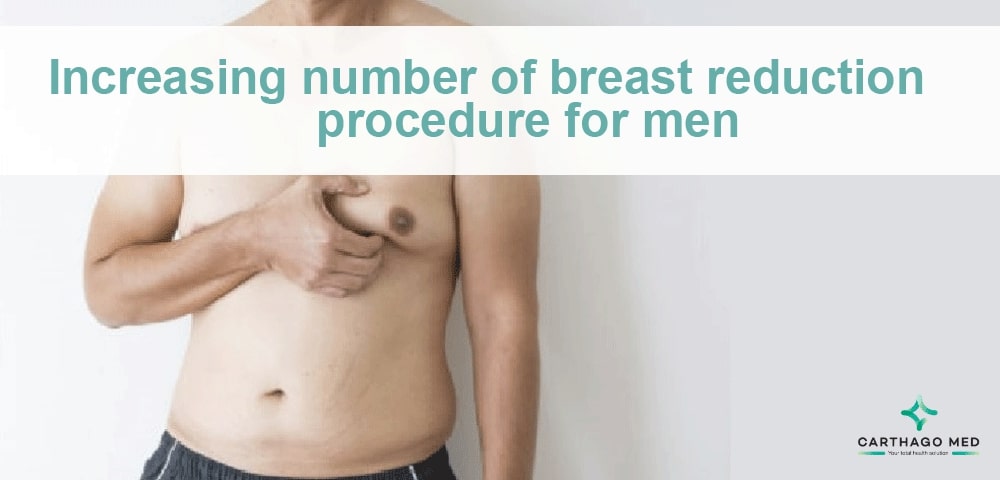
Increasing number of breast reduction procedure for men
Although breast reduction used to be performed mainly on women, nowadays it is also frequently performed on men. This operation is indicated for patients who suffer from breast enlargement, or gynecomastia. This phenomenon can cause aesthetic discomfort in men, and surgery is the best way to remedy it.
Is Cosmetic Surgery Among Men on the Rise, Especially Among the Youth?
According to various studies carried out on the subject, the number of men who have recourse to cosmetic surgery is clearly on the rise. In fact, in just ten years, this number has increased by about 11%. Of these patients, about 10% go to a surgeon for a breast reduction. It should also be noted that in general, cosmetic surgery today attracts mostly young men, between 20 and 30 years of age, more than older patients.
Why are male patients so keen on cosmetic surgery?
One of the prominent reasons behind this trend is the growing influence of social media pressure. In the age of Instagram and Facebook, individuals are constantly exposed to images of the so-called ‘ideal’ body, which can create significant psychological pressure to conform to these unrealistic standards.Furthermore, the prevalence of stigma surrounding cosmetic surgery has significantly reduced over the years. Men, just like women, now feel more comfortable openly discussing their insecurities and seeking solutions to enhance their appearance. This societal acceptance has encouraged more men to consider cosmetic procedures, including male breast reduction, as a viable option to achieve their desired look.
Another factor contributing to the increase in male breast reduction surgeries is the advancement in surgical techniques. Innovative methods like the pull-through technique have made these procedures less invasive, safer, and more effective. This technique, offered at renowned clinics such as Centre for Surgery, ensures minimal scarring and faster recovery periods, addressing concerns that were barriers to entry for many potential patients in the past.
During puberty, many boys experience hormonal imbalances that can lead to the development of abnormally enlarged male breasts, commonly referred to as man boobs. This condition often creates significant psychological distress, affecting self-confidence and hindering participation in physical activities. Consequently, the option of male breast reduction surgery becomes an appealing prospect, offering a solution that can positively impact both physical and mental well-being.The decision to undergo a plastic surgery procedure like male breast reduction is deeply personal and often driven by the desire to achieve the ideal body image. For many men, this quest for the ideal body involves addressing physical aspects that have a substantial impact on their self-esteem and body positivity.
What is gynecomastia?
Gynecomastia is a medical condition characterized by the enlargement of breast tissue in males, is an excessive development of one or both breasts. This condition can occur at any age and is relatively common. It is important to note that gynecomastia is different from fat accumulation in the chest area, which can happen due to obesity. Gynecomastia specifically involves the growth of glandular breast tissue. we speak of unilateral gynecomastia when one breast is affected and bilateral gynecomastia when both breasts are affected. This is a fairly common phenomenon in men, the chest has an overdeveloped appearance, and the patient complains of an unattractive and unmanly looking chest.
What are the causes of gynecomastia?
gynecomastia can appear as a result of a hormonal disorder, which is why it is a fairly recurrent phenomenon in adolescents who have just reached puberty. The use of certain drugs, such as those used to treat prostate cancer, can also cause gynecomastia. In addition, obesity, the consumption of alcoholic beverages, and a generally poor lifestyle can all contribute to gynecomastia. Finally, it is possible to identify idiopathic gynecomastia in some patients, which is a form of gynecomastia that appears for no particular reason.
What are the Aftermath Effects of Gynecomastia?
There is generally very little pain following the operation, which will eventually disappear in the weeks following discharge from the clinic. The surgeon may prescribe painkillers to ease the pain. You will need to take a few days off work, but if the patient does manual work, then a longer leave of absence should be planned. Sports activities can only be resumed after at least 4 weeks.The patient will notice some swelling in the operated area; this will eventually disappear after 3 to 4 weeks. The patient will have to wear a compression waistcoat for about 21 days, which will limit the swelling that results from the operation.Thanks to the modern techniques used in aesthetic medicine today, the risks of this procedure are very rare, and the results are in most cases very satisfactory.The excess of the mammary gland is permanently removed, and the patient can benefit from a flatter and more aesthetic breast. However, in some cases when the result is not optimal, a return to the clinic may be considered in order to make some adjustments after agreement with the aesthetic doctor.
What other procedures are frequently requested by men?
The quest for a more harmonious body and a younger, more attractive face is driving more and more men around the world to seek the services of a plastic surgeon. Among the operations most requested by men are liposuction (the stomach being the most targeted area), hair transplants (to permanently remedy baldness), and face lifts, to give them a second youth. Genioplasty is also becoming increasingly popular among men in recent years. This procedure is used to increase and reshape the shape of the chin, and many men want to have a more pronounced chin and therefore a more assertive face.
The rise of cosmetic surgery among men, especially procedures like gynecomastia surgery, signifies a transformative shift in how society perceives male body image. As men become more open to discussing their concerns and seeking solutions, the field of cosmetic surgery continues to evolve, offering tailored procedures that cater to the unique needs and desires of male patients in the United Kingdom, Canada, and beyond.









